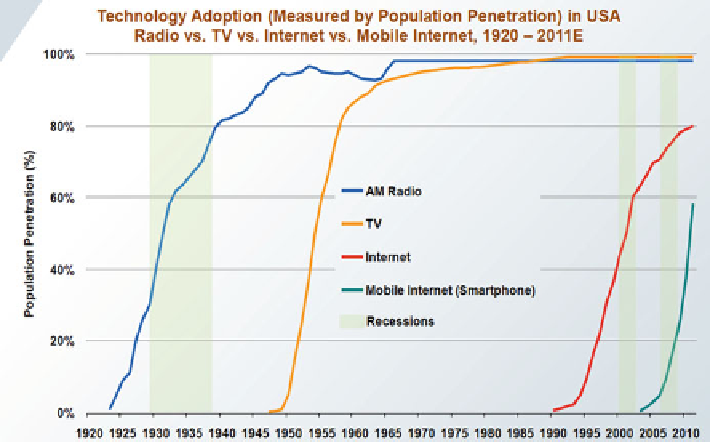Information Technology Reference
In-Depth Information
Fig. 13.2 Technology adoption (measured by population penetration in %), in USA, Radio/TV/
Internet/Mobile internet, 1920-2011. Source: Radio penetration data per Broadcasting & Cable
Yearbook 1996, Internet penetration data per World Bank/ITU, Mobile Internet (smartphone) data
per Morgan Stanley Research; 3G data per Informa
economics conditions. Even in recessions times, these technologies are successful.
As said Jean Schmitt, one famous VC in high tech industry: “some technologies do
breakout even in breakdown times”
Comments: Generic Concept and New Relationship “Design Space”/“Context”
Let's underline some properties of the designed alternative:
1. A conceptual alternative. The nature of d
n+1
is very different from all d
i
, i n:
the latter are known alternatives whereas the former is a concept (in the sense of
C-K theory: only a proposition that has no logical status). This is precisely
because every d
i
, i n are known that it is possible to evaluate for every d
i
,
i ¼1
...
n the costs or utility U(θ
j
, d
i
) for all θ
∈
Θ. By contrast, the only
2. Generic technology. If such an alternative d
n+1
exists, then this alternative is
valid “whatever θ, whatever μ”. Suppose that the states of nature are, for
instance, varied markets and d
i
are varied technologies to address—more or
less well- these markets. Then d
n+1
is a technology that addresses all the markets
in Θ. This is a generic technology. These technologies are well-known in
innovation economics (Bresnahan and Trajtenberg
1995
); but they are often
studied ex post, when the technology is already designed and has already won on
enables to go one step further:
3. Generic concept. Since strictly speaking, d
n+1
is not known but is a concept, we
call it a generic concept. If this concept is designed, it would lead to a generic

Search WWH ::

Custom Search